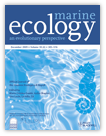Trophic Potential and Photoecology of Endolithic Algae Living within Coral Skeletons
Abstract
Abstract. The biomass of the endolithic algae Ostreobium quekettii Phyllosiphoniaceae living within skeletons of the scleractinans Mycedium elephantotus and Leptoseris fragilis averages 300 μg protein. cm-2. This represents approximately 7% of the protein of the zooxanthekie-containing tissue of M. elephantotus and approximately 38% of that of L. fragilis. Oxygen production Pmaxnet of 0. querkettii in bare skeletons of M. elephantotus averaged 0.7 μg O2.cm-2· h-1 measured in large skeletal fragments. This amount is approximately 6% of the productivity of the zooxanthellae Symbiodinium microadriaticum living in the same scleractinian species at the same depth Pmaxnet 11 μg O2· Cm-2· h-1. Light compensation of O. quekettii - within skeletons - was reached at approximately 10 and saturation at 35 40 μE·m-2· s-1. Algae within the M. elephantotus skeletons receive a maximum of 4–6% of the ambient irradiance, which is approximately 0.9 μE · m-2· s-1 approximately 0.04% surface irradiance at a depth of 88 m. In L. fragilis at a depth of 145 m, the photon flux decreases to 0.3 μE·m-2· s-1, which is less than 0.004% of surface intensity. With increasing depth, the ratio of Chl b to Chl a increased in endolithic algae colonizing L. fragilis, indicating improvement of light harvesting under low light conditions. In free-living O. quekettii cultured at irradiance levels from 0.5–60 μE·m-2· s-1, the concentrations of chlorophylls increased and that of siphonein and β-carotene decreased with decreasing photon flux.




